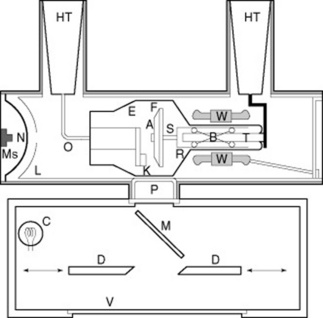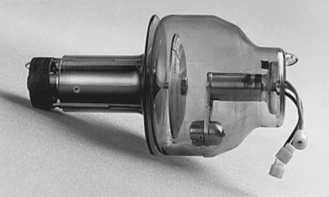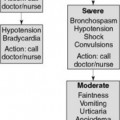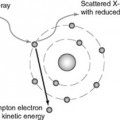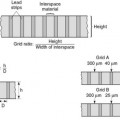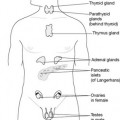Chapter 8 The X-ray tube
 The electrons are accelerated across a potential difference ranging from 40 to 120 kV in a diagnostic X-ray tube.
The electrons are accelerated across a potential difference ranging from 40 to 120 kV in a diagnostic X-ray tube. X-rays are produced as bremsstrahlung and characteristic radiation at the anode with an efficiency of around 1%.
X-rays are produced as bremsstrahlung and characteristic radiation at the anode with an efficiency of around 1%. The anode is rotated by an induction motor with coils outside the glass envelope and a copper rotor inside attached to the anode.
The anode is rotated by an induction motor with coils outside the glass envelope and a copper rotor inside attached to the anode. X-rays are produced at the focal spot on the anode, the smaller the focal spot the smaller the penumbra of the X-ray beam.
X-rays are produced at the focal spot on the anode, the smaller the focal spot the smaller the penumbra of the X-ray beam. X-rays are emitted in all directions from the tube but are constrained to a small area by a ‘window’ or port in the tube housing.
X-rays are emitted in all directions from the tube but are constrained to a small area by a ‘window’ or port in the tube housing.INTRODUCTION
Since the discovery of X-rays in 1895 by Roentgen and the heated cathode X-ray tube by Coolidge, X-ray tubes have developed into complex pieces of electromechanical engineering. They comprise around 350 parts, taking 150 assembly operations. The cost (at date of publication) can be as much as £20 000.
The key components of a modern rotating anode X-ray tube (Fig. 8.1) are:
TUBE HOUSING
The tube housing protects the delicate insert from damage during use (Fig. 8.2). It is made of steel or aluminium with an external protective coat of paint to allow easy cleaning and an internal lining of lead to reduce radiation leakage to below the required maximum. The cover has special mounting rings, trunions for attachment to the tube suspension equipment, and sealed terminals and sockets for the high-tension cables and other associated control equipment connections. On the external surface the tube is marked to indicate the position of the focus point of the anode and a plate indicates the electrical characteristics and date of manufacture.
VACUUM ENVELOPE
In order for the X-ray tube to operate, the anode and cathode need to be contained in a vacuum;this vacuum is contained within the tube envelope. The envelope needs to be strong enough to support the anode and cathode assemblies, provide electrical insulation between the two and maintain the vacuum. The tube vacuum envelope is generally made of glass although some high-power tube envelopes are made of metal or ceramic.





